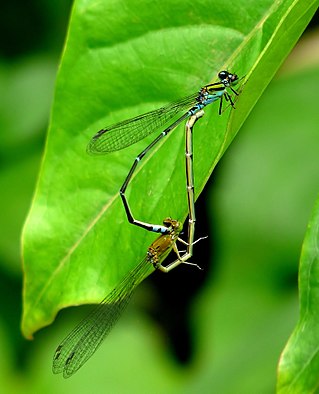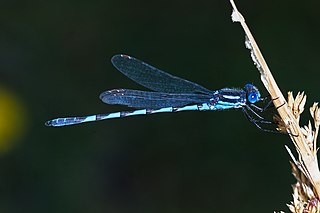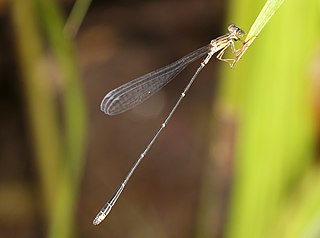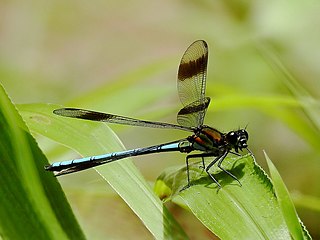
Epiophlebia laidlawi, the Himalayan relict dragonfly, is one of four species of Epiprocta in the family Epiophlebiidae. They have at one time been classified as a suborder Anisozygoptera, considered as intermediate between the dragonflies and the damselflies, partly because the hind wings and fore wings are very similar in size and shape, and partly because the insect at rest holds them back over the body as damselflies do. These attributes now are known to be misleading however; the genus Epiophlebia shares a more recent ancestor with dragonflies and became separated from other Anisoptera in and around the uplifting Himalayas.

Ischnura aurora, the gossamer damselfy or golden dartlet and also known as the aurora bluetail, is a species of damselfly in the family Coenagrionidae.

Pseudagrion is the largest genus of damselfly in the family Coenagrionidae, with over 140 species. Its range includes most of Africa, much of Asia, and Australia. Africa holds most of the diversity with almost 100 species. It has occupied most of the freshwater habitats in its range, and dominates damselfly communities in habitats as different as desert pools, equatorial rainforests and montane streams.

The red and blue damsel is a damselfly in the family Coenagrionidae. It is the only member of the monotypic genus Xanthagrion.

The eastern billabongfly is a damselfly in the family Coenagrionidae. It is also known as the eastern dart. Eastern billabongflies are small damselflies about 25mm (1 inch) in length. They are found near slow running water or still water, such as lakes, ponds and ditches. Male and female eastern billabongflies mate in a wheel position.

The Lestoideidae are a family of damselflies occurring in South-east Asia, New Guinea and Australia. The family comprises two genera and nine species.

Austrolestes is a genus of medium to large-sized damselflies in the family Lestidae. Austrolestes damselflies sit with their wings folded completely back. Males are usually bright blue and black, the females duller. Members of this genus are found in Australia, New Zealand and South Pacific islands.

Diphlebiidae is no longer recognised as a biological family. It was the name given to a small family of damselflies, the azure damselflies, with species in two genera: Diphlebia and Philoganga. Diphlebia is found in Australia and Philoganga is found in Southeast Asia. They are large and thick-bodied damselflies. They rest with their wings spread out. The Diphlebiidae were also known as Philogangidae.

Austroargiolestes is a genus of damselflies in the family Argiolestidae. They are commonly known as Flatwings; unlike many other damselflies, at rest their wings are spread out flat.

Austrolestes colensonis, commonly known as the blue damselfly, is a species of damselfly of the family Lestidae. It is endemic to New Zealand and can commonly be found throughout the country, and at any time of the year. It is New Zealand's largest damselfly, and only blue odonate.

Diphlebia euphoeoides, sometimes spelled Diphlebia euphaeoides, known as the tropical rockmaster, is an Australian species of broad winged damselfly. It is one of a group known as the azure damselflies. It is found in Queensland (Australia) and Papua New Guinea. It typically occurs near lakes, waterfalls or streams at relatively low altitudes, and is occasionally seen near dry pools.

Diphlebia coerulescens, known as the sapphire rockmaster, is an Australian species of broad winged damselfly. It is one of a group known as the azure damselflies. It is found in Queensland and north-eastern New South Wales in eastern Australia, where it is found in fast-flowing streams and rivers.

Austroagrion is a genus of damselflies belonging to the family Coenagrionidae. Species of Austroagrion are small damselflies; males are black with blue or green markings while females are paler. Austroagrion occurs in Papua New Guinea, New Caledonia and Australia.

Caliagrion is a monotypic genus of damselflies belonging to the family Coenagrionidae. The single species of this genus, Caliagrion billinghursti, is commonly known as a large riverdamsel, and is endemic to south-eastern Australia, where it inhabits slow-flowing rivers and ponds.

Oristicta filicicola is a species of damselfly belonging to the family Isostictidae. Until 2017 it was the only species of the genus Oristicta. Commonly known as a slender wiretail, it is a slender and dull-coloured damselfly of medium-size. It is endemic to north-eastern Australia, where it inhabits streams in rainforests.

Synlestes is a genus of damselflies in the family Synlestidae. Species of Synlestes are very large damselflies, metallic green to dark bronze or black in colour with white, yellow or orange markings. Unlike many other damselflies, they spread their wings when resting. They are endemic to eastern Australia where they inhabit streams.

Diphlebia hybridoides is a species of Australian damselfly in the family Lestoideidae, commonly known as a giant rockmaster. It is endemic to north-eastern Queensland, where it inhabits streams in forests.

Diphlebia nymphoides is a species of Australian damselfly in the family Lestoideidae, commonly known as an arrowhead rockmaster. It is endemic to eastern Australia, where it inhabits streams and rivers.

Diphlebia lestoides is a species of Australian damselfly in the family Lestoideidae, commonly known as a whitewater rockmaster. It is endemic to south-eastern Australia, where it inhabits streams and rivers.



















